Biden’s Project Labor Agreement Schemes Exacerbate Construction Industry’s Skilled Labor Shortage
The construction industry is projecting a historic shortage of 650,000 skilled workers in 2022. It is also facing serious supply chain disruptions, unprecedented materials cost inflation of 44% since prior to the COVID-19 pandemic and declining investment in nonresidential structures.
The Biden administration is aware of these problems that stand to undermine taxpayer investments in the $1.2 trillion infrastructure bill and other measures funding America’s neglected infrastructure, yet it continues to push anti-competitive and costly policies promoting controversial government-mandated project labor agreements on federal and federally assisted taxpayer-funded construction projects, which are sure to exacerbate the construction industry’s skilled workforce shortage and needlessly increase the cost of taxpayer-funded infrastructure projects by 20%.
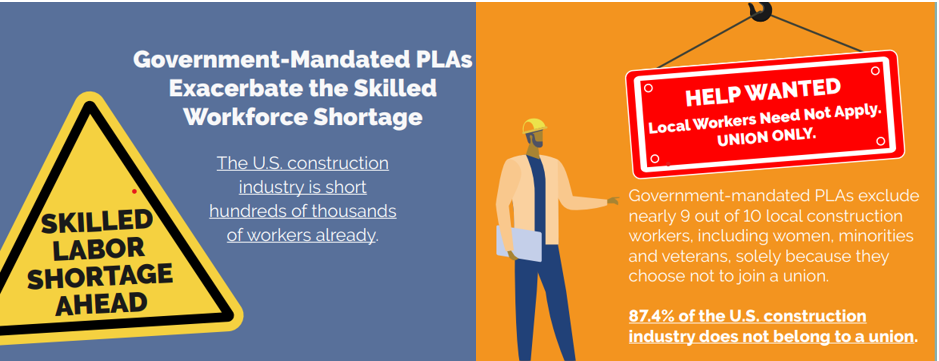
The construction industry needs to hire an additional 650,000 craft professionals in 2022, according to an analysis of U.S. Bureau of Labor Statistics data released Feb. 23, 2022, by Associated Builders and Contractors.
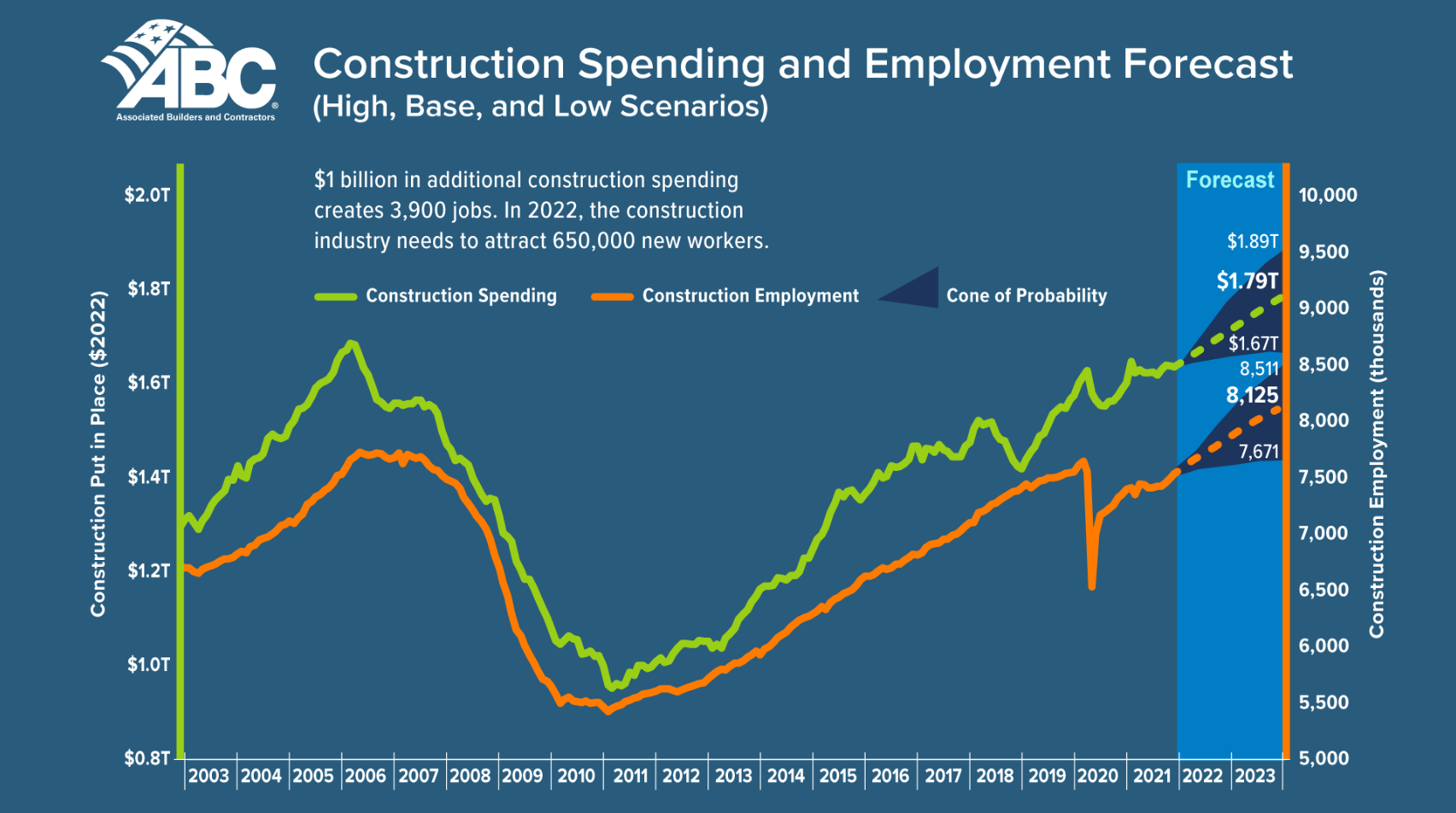
However, PLAs typically force contractors to replace most or all nonunion labor with labor from union hiring halls. In addition, PLAs force contractors to hire apprentices exclusively from union-affiliated apprenticeship programs, as specified in the PLA or applicable union’s collective bargaining agreement referenced in the PLA.
For example, Article 13 of the PLA mandated by District of Columbia lawmakers on the federally assisted South Capitol Street Corridor P—Phase 1 Project has the following problematic apprenticeship language (see page 42), which forces contractors to use apprentices affiliated with union programs instead of their own existing apprentices, who are not affiliated with union programs:
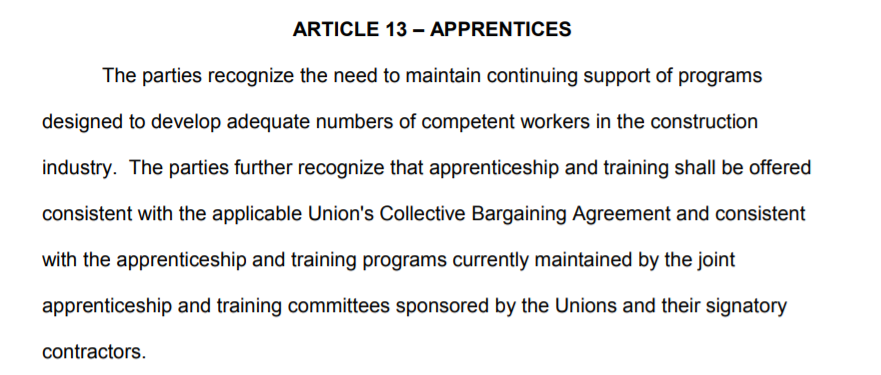
This project received federal assistance from the U.S. Department of Transportation’s Federal Highway Administration, which also approved the PLA mandated by the District of Columbia government.
The Biden administration’s pro-PLA policies are extremely problematic for the industry’s current and future skilled labor shortage because more than 87% of the U.S. construction workforce chooses not to belong to a union.
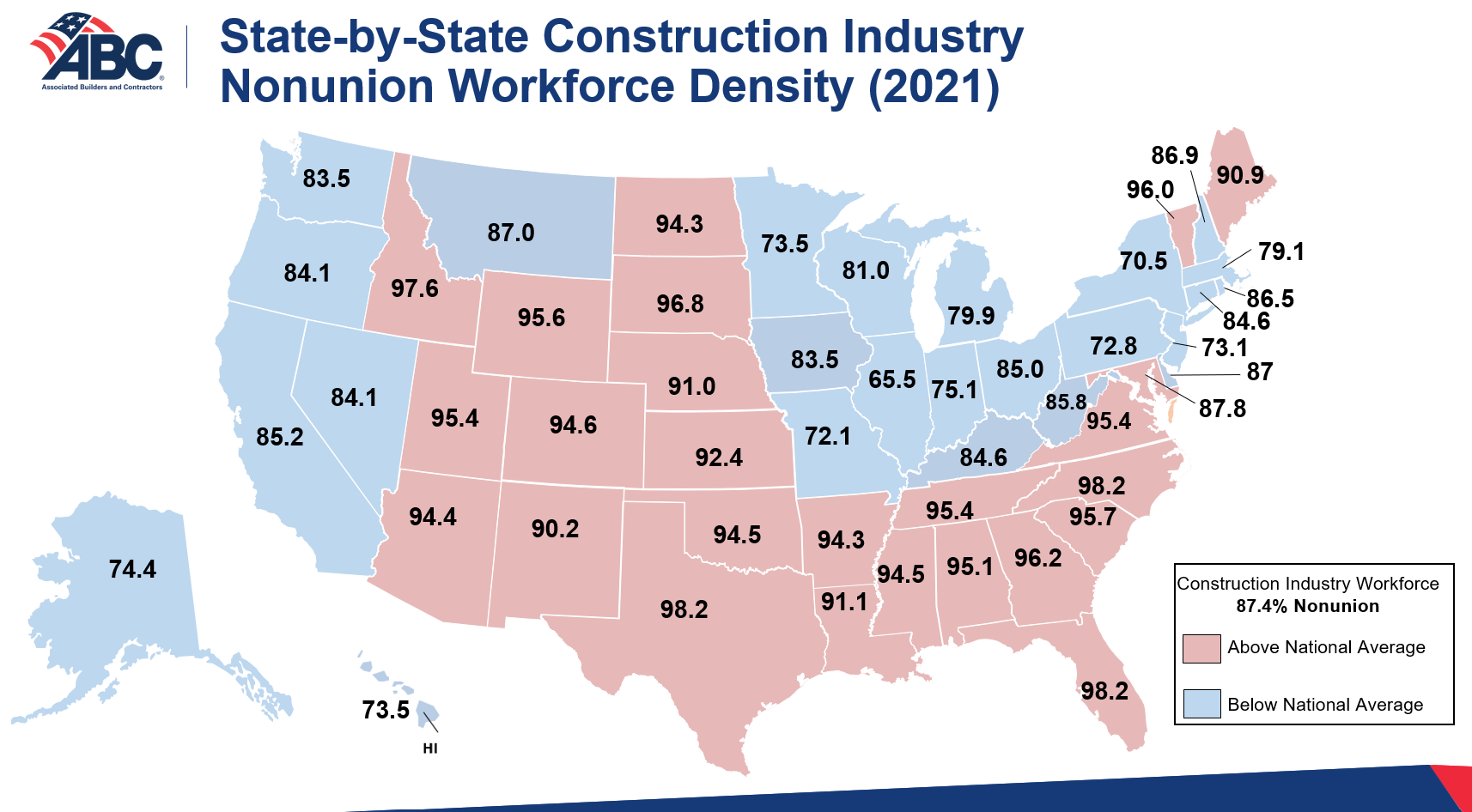
The truth is the vast majority of tomorrow’s construction industry workforce—those participating in government-registered apprenticeship and industry apprenticeship programs not affiliated with unions—would not be able to meaningfully participate on government-mandated PLA jobs, stifling a key workforce development pipeline of skilled labor needed to meet America’s future infrastructure needs.
Government-Mandated PLAs Limit Industry Workforce Development Efforts
According to the results of ABC’s 2022 Workforce Development Survey, ABC contractor members invested $1.6 billion on workforce development initiatives in 2021, providing craft, leadership and safety education to 1.3 million course attendees to advance their careers in commercial and industrial construction.
ABC, its 68 chapters and more than 21,000 members and workforce development partners are educating craft, safety and management professionals using innovative and flexible learning models like just-in-time task training, competency-based progression, work-based learning and—with more than 300 government-registered apprenticeship programs across 20 different occupations—developing a safe, skilled and productive workforce.
This strategy not only helps the construction industry’s workforce become educated and achieve their career goals, but also recognizes every worker is unique in their desires, skills and dreams, which helps connect high school students, minorities, reentering citizens, veterans and women to rewarding careers in construction.
ABC’s investment in an all-of-the-above approach to workforce development has produced a network of ABC chapters and affiliates in hundreds of locations across the country that offer more than 800 apprenticeship, craft, safety and management education programs—including more than 300 U.S. Department of Labor and state equivalent government-registered apprenticeship programs across 20 different occupations—to build the people who build America.
When ABC signed the Pledge to America’s Workers at the White House in July 2018, it promised to educate and develop at least 500,000 construction workers by 2023. ABC far exceeded that goal in 2020.
Unfortunately, PLA lobbyists and advocates often disparage ABC’s inclusive workforce development programs and efforts to promote an all-of-the-above workforce development solution to the construction industry’s skilled labor shortage crisis because it threatens their market share and investments in union-affiliated government-registered apprenticeship programs.
A 2015 report issued by construction unions claims that, “among construction apprentices, 74 percent are trained in the unionized construction industry.” (Note: The DOL does not make this data of union versus nonunion apprentices enrolled in registered apprenticeship programs available in an aggregate version/report, so data must be requested and calculated through individual requests.)
Besides pushing for anti-competitive and costly government-mandated PLAs, unions lobby their buddies in government to steer taxpayer-funded grants to union apprenticeship programs, create apprenticeship-to-journeyman ratios favorable to unions and mandate apprenticeship program participation requirements on taxpayer-funded public works projects and private clean energy projects in order to cut competition from nonunion firms, resulting in more contracts for union-signatory contractors and more jobs for union members.
The truth is that the vast majority of the construction industry workforce has never participated in union-affiliated apprenticeship programs or government-registered apprenticeship programs.
In addition, some lawmakers and stakeholders are unaware these apprenticeship programs are not keeping up with industry demand for skilled labor to meet the current backlog of construction projects—which stood at nine months in May 2022, according to ABC’s June Construction Backlog Indicator—and future spending expectations.
Data from the DOL indicates that, in 2021, a total of just 23,881 apprentices from the 23 Office of Apprenticeship states and Guam completed construction apprenticeship programs registered with the DOL. To be clear, the data is from federal OA-registered programs affiliated with construction unions and programs not affiliated with unions such as those run by ABC chapters, ABC member contractors, industry associations, community and technical education workforce development programs.
Of note, there are other government-registered apprenticeship programs regulated by states that are similar to the registered programs receiving oversight by the OA. However, it is unknown how many apprentices completed construction industry apprenticeship programs registered with such state agencies, known as State Apprenticeship Agencies, in 2021.
The DOL’s Registered Apprenticeship Partners Information Data System, which receives data from all 23 OA states and 11 of the remaining SAA states plus Guam, estimated that, in 2021, a total of 32,068 apprentices completed construction industry registered apprenticeship programs from RAPIDs participating states.
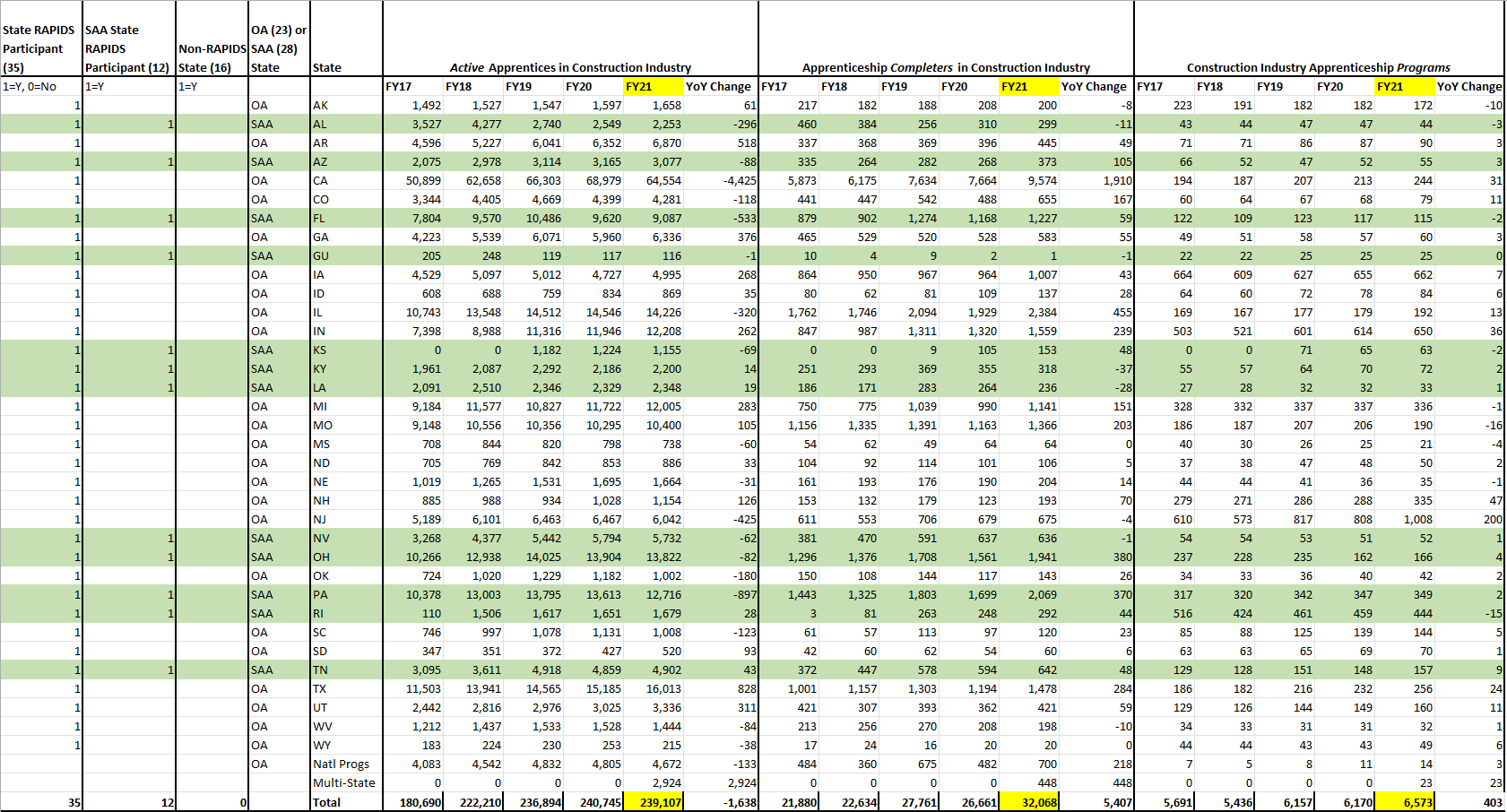
While it cannot be verified by the DOL data due to data limitations in the RAPIDS program, it is estimated that about 40,000 to 45,000 construction industry apprentices completed government-registered apprenticeship programs from all 50 OA and SAA states and the District of Columbia in 2021.
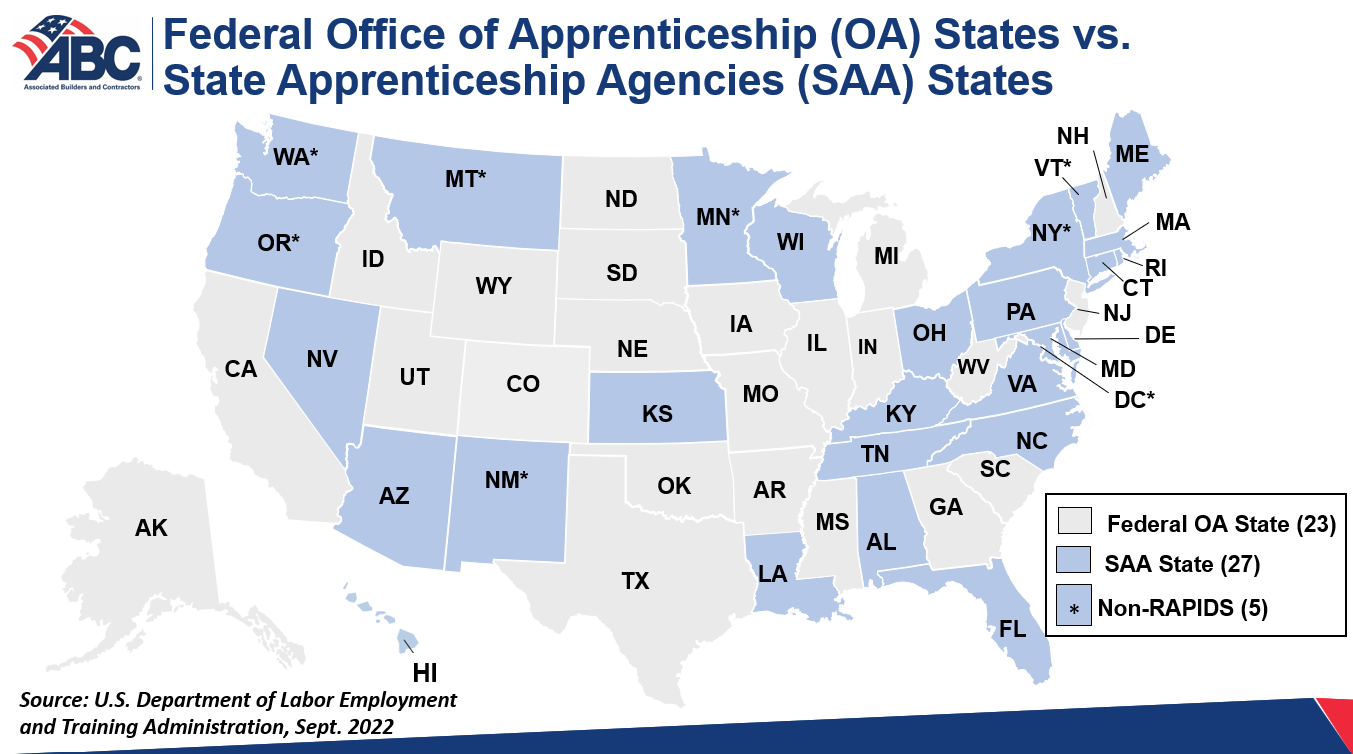 (Map PPT, New Map PPT as of 9/15/22)
(Map PPT, New Map PPT as of 9/15/22)
At 2021 rates of completion, it would take more than 14 years for all government-registered construction industry apprenticeship program completers to fill the estimated 650,000 vacant construction jobs needed just in 2022.
(Note: Since this blog post was published, the DOL updated its website with new FY 2021 data; however, it did not publish the number of completers in the construction industry as it had in previous years such as this chart for FY 2020. In addition, it was brought to our attention that Alabama (2019) and Tennessee (2021) switched from OA to SAA states so maps and data have been updated accordingly. In addition, In September 2022 the DOL indicated that more states are participating in the RAPIDS program currently, as reflected in this map, but the 2021 data above may not reflect this switch yet but it will be reflected in 2022 data published in 2023.)
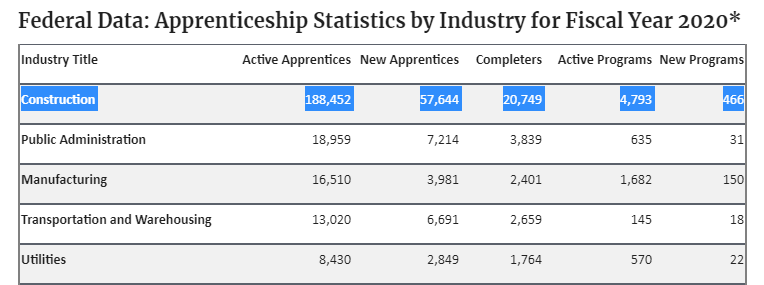
The Construction Industry Needs Lawmaker Support of an All-of-the-Above Workforce Development Strategy
These data demonstrate that the vast majority of upskilling and workforce development in the construction industry occurs outside of union and nonunion government-registered apprenticeship programs. In addition, an even greater amount of construction industry workforce development and upskilling occurs in programs not affiliated with union-affiliated government-registered apprenticeship programs because the union apprenticeship programs are almost all registered with the DOL or state equivalents and are captured in reported government data.
This is why government-mandated PLAs and other policies that require employers to use apprentices from union-affiliated and/or government-registered apprenticeship programs can be problematic from a practical perspective. Excluding the workforce development systems already in place exacerbates the skilled labor shortage facing the entire construction industry by steering work to participants in union-affiliated, government-registered apprenticeship programs at the expense of every other contractor bidding for work who engages in alternative workforce development efforts.
In short, there needs to be a commitment by policymakers to enact an all-of-the-above workforce development strategy where workers and employers have the freedom to choose the best way to rebuild America’s construction workforce to rebuild America.
ABC Survey Shows Government-mandated Project Labor Agreements Harm Investments in Workforce Development
ABC members overwhelmingly said government-mandated PLAs harm their company hiring and workforce development practices and ability to complete work safely, on time and on budget.
Almost 97% of survey respondents said the PLA provisions that would require their firm to hire most or all of their company’s apprentices from union-only apprenticeship programs would harm their company’s investment in workforce development programs.
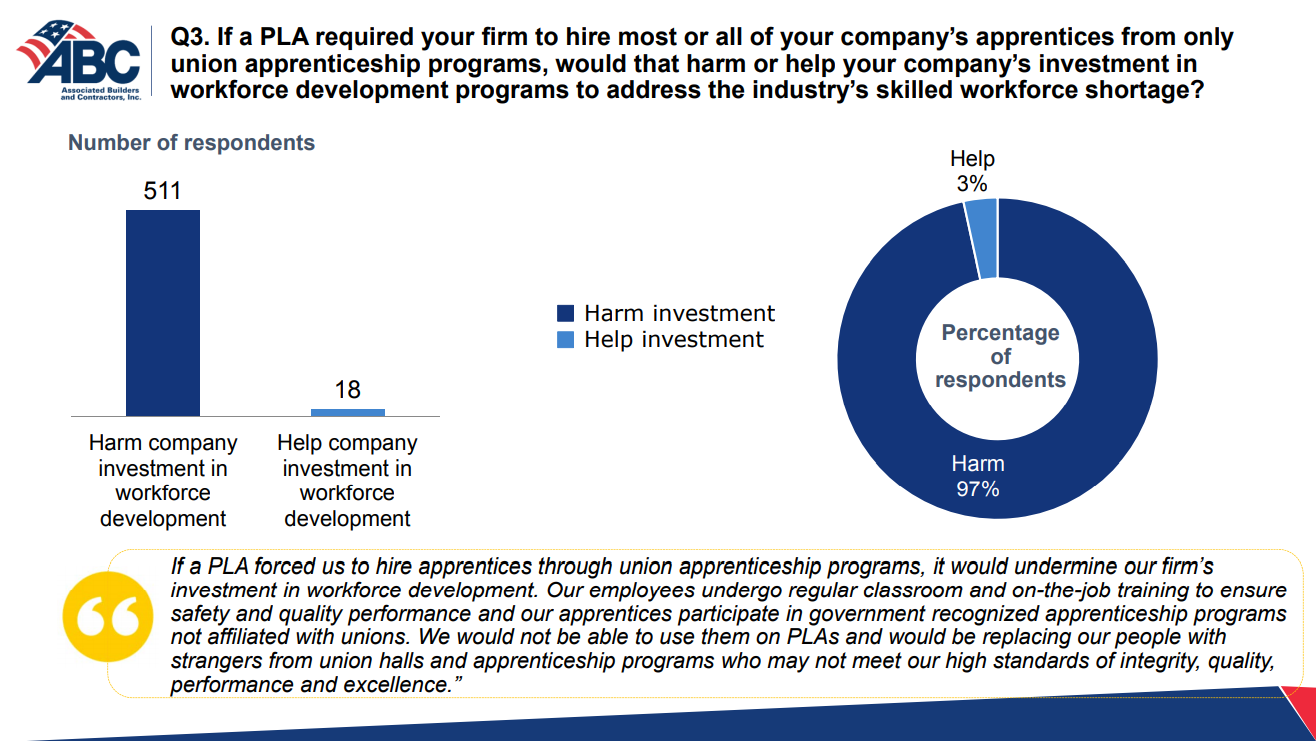
Of ABC survey respondents, 98% said they were less likely to bid on a taxpayer-funded construction contract if the bid specifications required the winning firm to sign a PLA with labor unions, and 97% of survey respondents said a construction contract that required a PLA would be more expensive compared to a contract procured via fair and open competition.
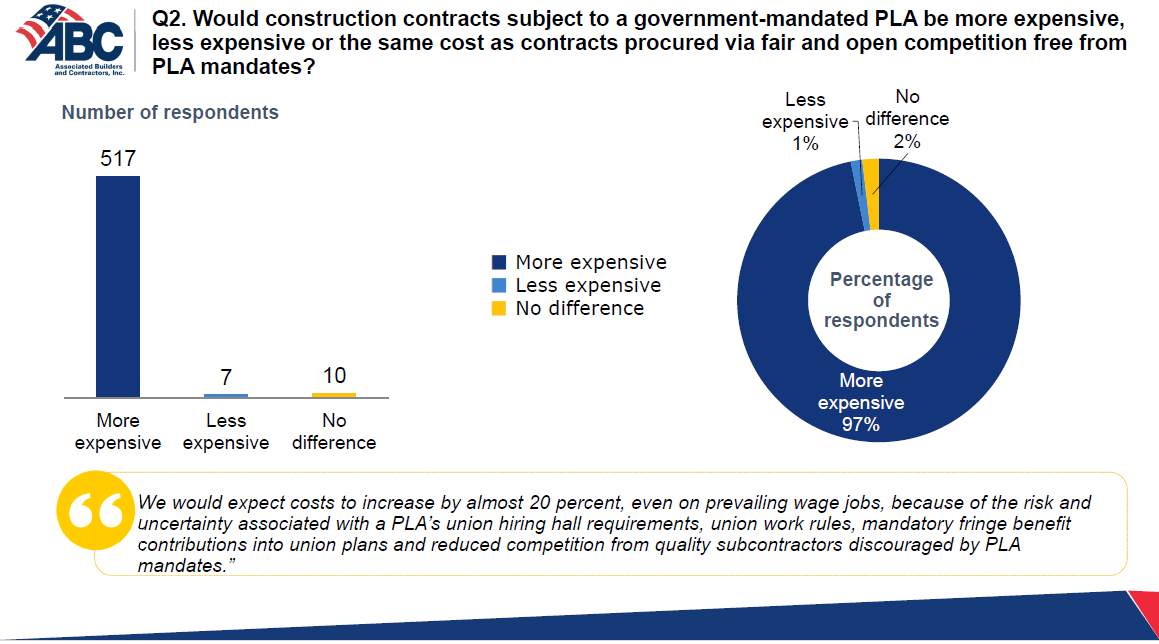
A clear majority of the more than 500 survey respondents affirmed that government-mandated PLAs are anti-competitive and discourage quality contractors. These PLAs discourage the more than 87% of U.S. construction workers who choose to not join a union from bidding and working on projects in their own local communities, which are paid for by their own tax dollars.
In fact, 97% of survey respondents said a PLA would result in worse local hiring outcomes for a project. In addition, almost 90% of respondents agreed that a PLA would decrease the hiring of women, veteran and disadvantaged business enterprises and construction workers, which have traditionally been unaffiliated with labor unions.
Corrupt Government-mandated PLAs Rig the Bidding Process
While ABC’s campaign against anti-competitive PLA mandate schemes on direct federal projects from 2009 to 2021 has been largely successful, lawmakers requiring and encouraging the use of special interest-favoring PLA mandates on non-federal projects funded by federal, state and local tax dollars continues to needlessly cost hardworking taxpayers nearly 20% more per project.
PLA mandates rig the bidding process to discourage experienced nonunion and some union contractors and their qualified workforce from competing to build transformational taxpayer-funded projects. And they deny good-paying, local jobs to the more than 87% of U.S. construction industry workers who choose not to affiliate with unions.
Problematic terms in government-mandated PLAs discourage competition by forcing contractors to:
- Use union hiring halls to obtain most or all workers instead of their existing workforce;
- Obtain apprentices exclusively from union apprenticeship programs.
- Follow inefficient union work rules;
- Pay into union benefits and multiemployer pension plans that the few nonunion employees permitted on the project will be unlikely to access unless they join a union and vest in these plans; and
- Require their existing workforce to accept union representation, pay union dues and/or join a union as a condition of employment and receiving benefits on a PLA jobsite, resulting in an estimated 34% hit to the paychecks of nonunion craft professionals on PLA projects.
Potential PLA mandates on taxpayer-funded contracts expose officials to intense political pressure, as construction unions raise and spend millions of dollars to help elect lawmakers willing to pass policies that grant donors a monopoly on public works construction projects.
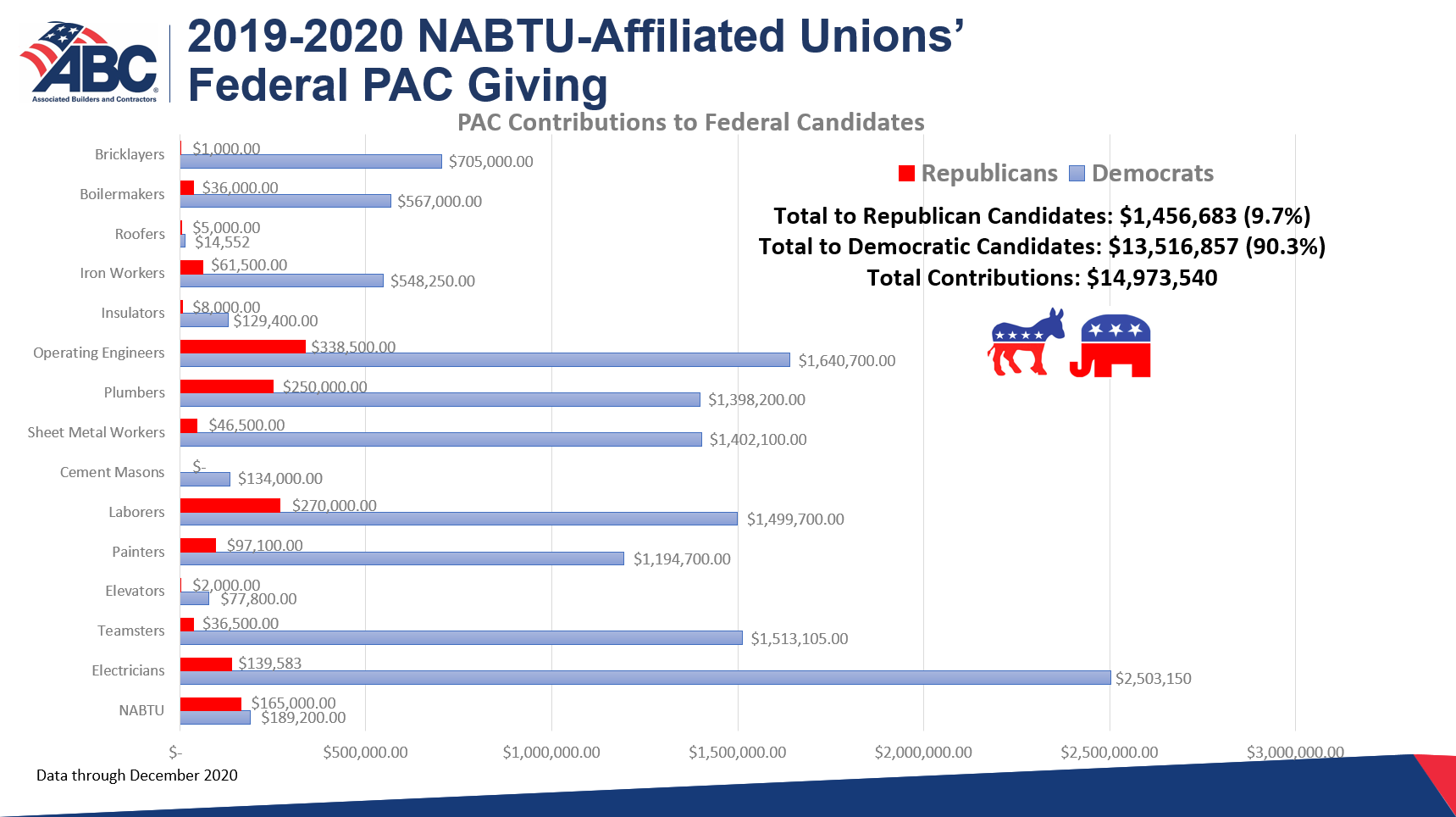
Biden Administration Mandates PLAs on Federal Construction Projects
Since President Biden signed Executive Order 14063, Use of Project Labor Agreements for Federal Construction Projects, on Feb. 4, 2022, mandating PLAs on federal construction projects of $35 million or more, numerous lawmakers and taxpayer and business groups have renewed fierce opposition to the Biden administration’s push for government-mandated PLAs on both federal and federally assisted public works projects.
Following the passage of the PLA-free $1.2 trillion Infrastructure Investment and Jobs Act infrastructure bill—and other measures providing hundreds of billions of dollars for federal, state and local government-procured construction contracts funded by taxpayers’ dollars—the construction industry and taxpayer advocates are poised for an advocacy battle with construction trade unions and other pro-PLA special interest groups and lawmakers. It will determine the fate of tens of billions of dollars’ worth of construction contracts and new jobs for millions of construction workers in the industry.
ABC slammed the Biden EO in a Feb. 3 statement picked up in dozens of publications nationwide: “This anti-competitive and costly executive order rewards well-connected special interests at the expense of hardworking taxpayers and small businesses who benefit from fair and open competition on taxpayer-funded construction projects.”
A Feb. 9 ABC op-ed in The Wall Street Journal laid out arguments against the Biden administration’s policy and concluded, “Taxpayers would be best served by the adoption of inclusive, win-win policies that help America’s construction industry realize the potential of the Infrastructure Investment and Jobs Act of 2021. We can’t rebuild our nation’s crumbling infrastructure effectively, increase accountability and reduce waste with PLAs.”
On Feb. 15, ABC and a coalition of 15 organizations representing tens of thousands of companies and millions of employees in the construction industry sent a letter to President Biden opposing EO 14063 and additional “policies encouraging PLAs on federally assisted projects via grant programs administered by federal agencies for state and local governments.” The coalition urged the White House to support “inclusive, win-win policies that welcome all of America’s construction industry to compete to rebuild our nation’s infrastructure, increase accountability and reduce waste and favoritism in the procurement of federal and federally assisted construction projects.”
On Feb. 28, ABC and a coalition of 19 organizations from the construction industry and the business community sent a letter to Congress in support of the Fair and Open Competition Act (S. 403/H.R. 1284), which would restrict government-mandated PLAs on federal and federally assisted construction projects. Similar pro-taxpayer legislation has been enacted in 24 states.
On March 7, Sen. Todd Young, R-Ind., led a group of 42 Senate Republicans in sending a letter to President Biden opposing EO 14063, saying that “a fair and open bidding process for federal construction projects would guarantee the best value for hardworking taxpayers located in all geographies and regions across the United States.”
On March 8, Rep. Ted Budd, R-N.C., and 59 House members signed a letter to President Biden saying that PLA mandates and preferences will “deny critical construction jobs to local workers and small businesses,” urging the White House to refrain from “attaching strings to infrastructure funding that create discriminatory barriers to recovery.”
On April 6, ABC announced it sent a letter to the White House signed by more than 1,200 ABC member contractors and chapters in opposition to the Biden administration’s pro-PLA policies. The Washington Post covered the letter in a April 14 column as did Fox Business News during an April 18 segment.
ABC estimates that EO 14063, once finalized via a forthcoming rulemaking by the FAR Council, could impact 120 federal contracts valued at $10 billion, which is roughly 40% of the value of federal construction put in place on an annual basis.
Biden’s Alarming PLA Push on State and Local Infrastructure Projects
Independent of Executive Order 14063 applying to federal contracts of $35 million or more, other policies by the Biden administration push PLAs on competitive grant and leasing programs administered by federal agencies affecting billions of dollars’ worth of federally assisted construction projects procured by state and local governments.
To date, the total federal funding and leasing programs infected with PLA mandates/preferences by misguided federal agency policies is $89.812 billion, although it is unclear how many of these projects will end up with PLA mandates on them until state and local governments put infrastructure projects out to bid to the contracting community. The public can track these federal agency grant and leasings programs at https://abc.org/plagrants.
In the words of Alabama Gov. Kay Ivey, states are aware of the Biden administration’s pro-PLA schemes on federally assisted construction projects:
In addition, new lose-lose federal agency policies make it difficult for Alabama to win competitive grants for federal infrastructure dollars to improve roads and utilities unless we agree to mandate union labor by requiring contractors to follow union collective bargaining agreements. If we capitulate to their policy-favoring special interests, out-of-state contractors and labor will win contracts, denying jobs to local, experienced firms and workers. If we don’t agree, federal infrastructure money will flow into other states willing to turn a blind eye to discrimination. Either way, all taxpayers are denied the benefits of open competition and the free market.
Likewise, on April 26, almost 20 GOP governors sent a letter to the White House opposing the Biden administration’s pro-PLA policies impacting federal and federal assisted construction projects in their states because it “will undermine taxpayer investment in billions of dollars of forthcoming public works projects financed by the Infrastructure Investments and Jobs Act of 2021 and additional bipartisan legislation passed by Congress, all of which was signed into law free from language requiring or encouraging the use of PLAs.”
ABC issued a press release supporting the GOP Governors’ letter.
In 2009, President Obama issued EO 13502 in 2009, which encourages federal agencies to mandate PLAs on large-scale federal construction projects exceeding $25 million in total cost on a case-by-case basis and permits recipients of federal assistance to mandate PLAs on state and local public works projects. Since the Obama order was issued, 26 states responded to the threat of discriminatory PLA mandates and preferences by enacting Fair and Open Competition Act legislation prohibiting government-mandated PLAs on state and local taxpayer-funded construction projects to some degree to send a message to the federal government that PLA mandates are not welcome on local projects.
Unfortunately, some states rolled back common-sense FOCA measures following Democratic party takeovers of state government, bringing the total number of current states with active pro-taxpayer FOCA measures to 24.
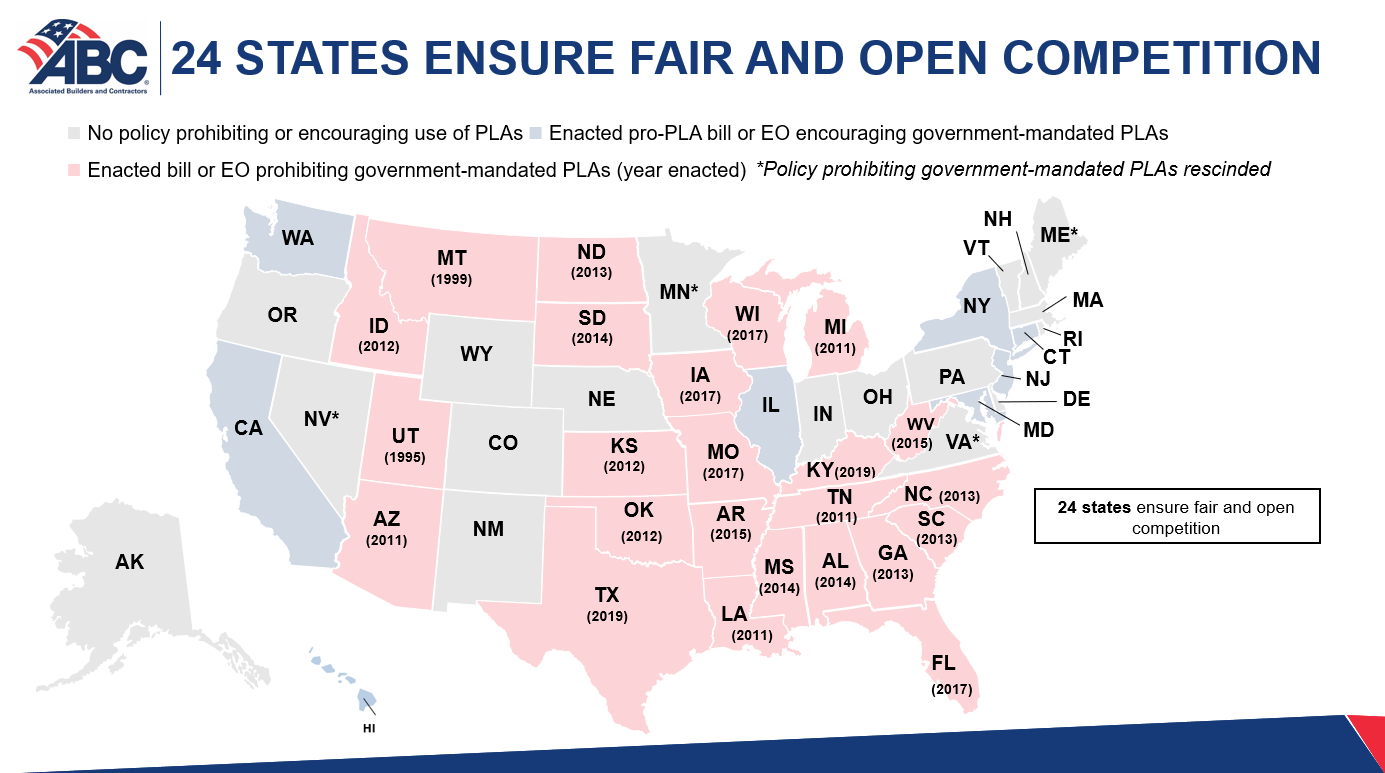
To date, all legal challenges to state and federal FOCA policies ensuring government neutrality in public works contracting have failed.
ABC’s efforts to enact state FOCA laws prevented government-mandated PLAs on $781.5 billion worth of construction capital outlay through the end of 2020.
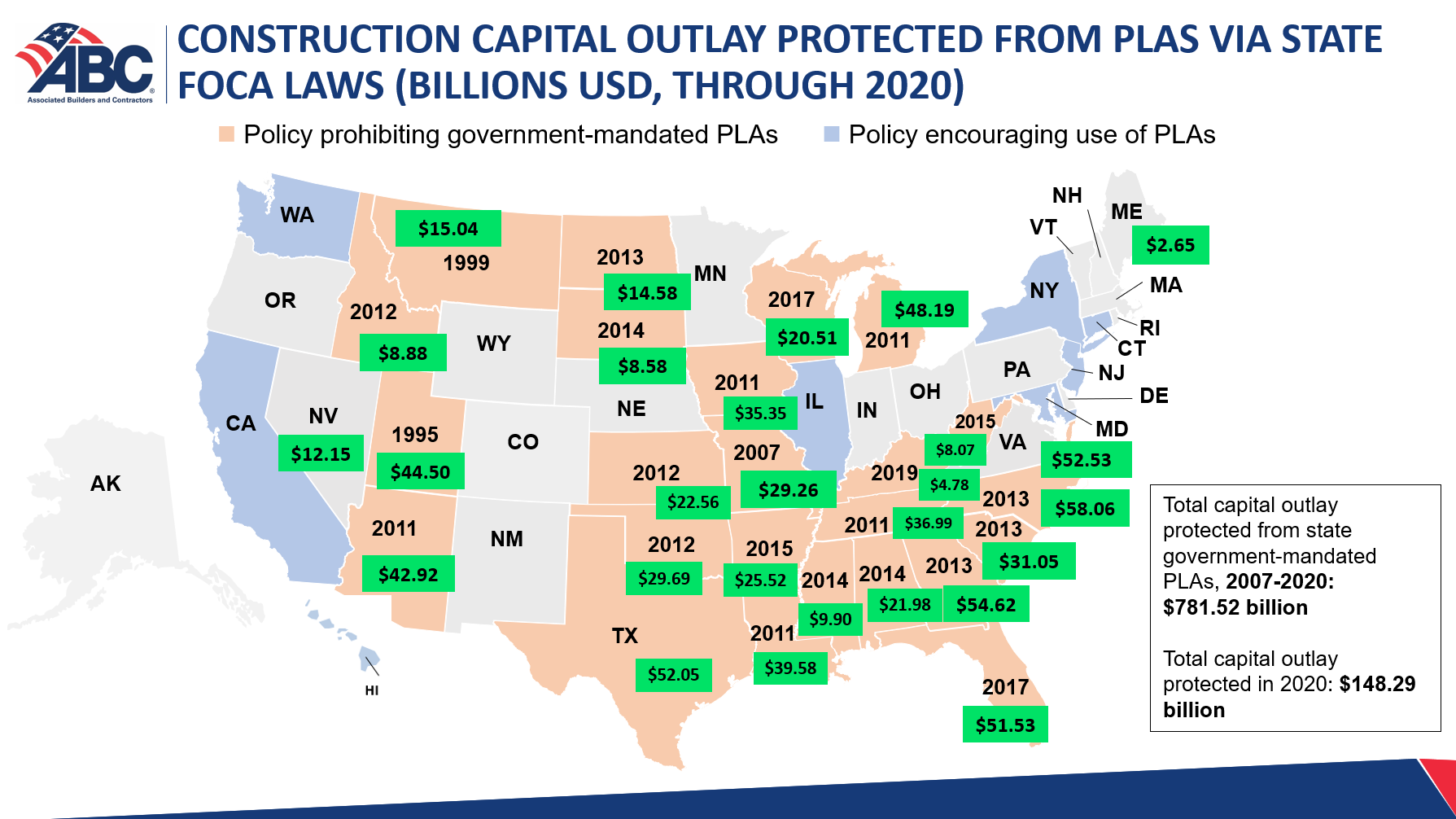
In addition, dozens of communities across the country have also enacted similar FOCA laws.
These efforts ensure a level playing field, increase competition, reduce costs and eliminate cronyism in public works contracting procured by state and local governments. More states may pursue these statutes in 2023 legislative sessions following the mid-term elections in November.
However, these state and local laws and ordinances do not prevent PLA mandates and preferences required by federal agencies procuring direct federal government construction contracts subject to federal law.
In addition, the Biden administration’s push for PLAs on federally assisted projects will be another misguided reason for blue states and local governments supportive of PLA mandate policies to require the use of PLAs on taxpayer-funded construction projects in order to qualify for federal grants and project approval, etc.
Continuing the #NoPLAs Fight
ABC and TheTruthAboutPLAs.com have long been leaders in opposing government PLA mandates and preferences on taxpayer-funded construction projects procured by local, state and federal governments.
We will continue to lead the fight against this anti-competitive and costly EO—and other separate Biden administration policies pushing PLA mandates on federally assisted contracts—with every legal, legislative, public relations, regulatory, grassroots and educational tool in our advocacy toolbox.
Learn more about government-mandated PLAs and Biden administration pro-PLA policies via ABC’s new FAQ document and coalition website at BuildAmericaLocal.com. Urge lawmakers to co-sponsor federal legislation restricting government-mandated PLAs on federal and federally assisted construction projects via this ABC grassroots campaign.
ABC and a diverse coalition of organizations will continue to prioritize defending fair and open competition in public contracting during the remainder of the 117th Congress and President Biden’s term.
ABC and the coalition support the Fair and Open Competition Act (S. 403/H.R. 1284), reintroduced in the 117th Congress by Sen. Young and Rep. Budd, which would restrict government-mandated PLAs on federal and federally assisted construction projects.
ABC will continue to fight for federal, state and local policies that create a level playing field in the procurement of government construction contracts, increase competition, help small businesses grow, curb construction costs and spread the job-creating benefits of taxpayer- funded contracts throughout the entire construction industry.
But we cannot do it alone. Concerned taxpayers and the merit shop contracting community can overcome these discriminatory PLA schemes as long as stakeholders and industry leaders remain diligent, support candidates who believe in free enterprise during the critical midterm elections, engage in grassroots advocacy and continue to educate lawmakers, employees and stakeholders about this campaign until a political or legislative solution is achievable.
Leave us some thoughts or comments below. Your input is valuable to us.












2 Responses to Biden’s Project Labor Agreement Schemes Exacerbate Construction Industry’s Skilled Labor Shortage
[…] on federal construction projects of $35 million or more. PLA schemes needlessly increase costs and exacerbate the construction industry’s skilled labor shortage because they exclude almost nine out of 10 workers from participating in these […]
[…] projects of $35 million or more. PLA schemes needlessly increase costs and exacerbate the construction industry’s skilled labor shortage because they exclude almost nine out of 10 workers from participating in these […]